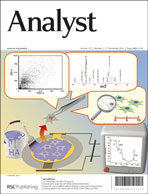The heptapeptide ARHPHPH was identified from biofilms and planktonic cultures of two different strains of Enterococcus faecalis, V583 and ATCC 29212, using matrix assisted laser desorption ionization mass spectrometry (MALDI-MS). ARHPHPH was also imaged at the boundary of cocultured, adjacent E. faecalis and Escherichia coli (ATCC 25922) biofilms, appearing only on the E. faecalis side. ARHPHPH was proteolyzed from κ-casein, a component in the growth media, by E. faecalis microbes. Additionally, top down and bottom up proteomic approaches were combined to identify and spatially locate multiple proteins within intact E. faecalis V583 biofilms by MALDI-MS. The resultant tandem MS data were searched against the NCBInr E. faecalis V583 database to identify thirteen cytosolic and membrane proteins which have functional association with the cell surface. Two of these proteins, enolase and GAPDH, are glycolytic enzymes known to display multiple functions in bacterial virulence in related bacterial strains. This work illustrates a powerful approach for discovering and localizing multiple peptides and proteins within intact biofilms.

You have access to this article
 Please wait while we load your content...
Something went wrong. Try again?
Please wait while we load your content...
Something went wrong. Try again?


 Please wait while we load your content...
Please wait while we load your content...